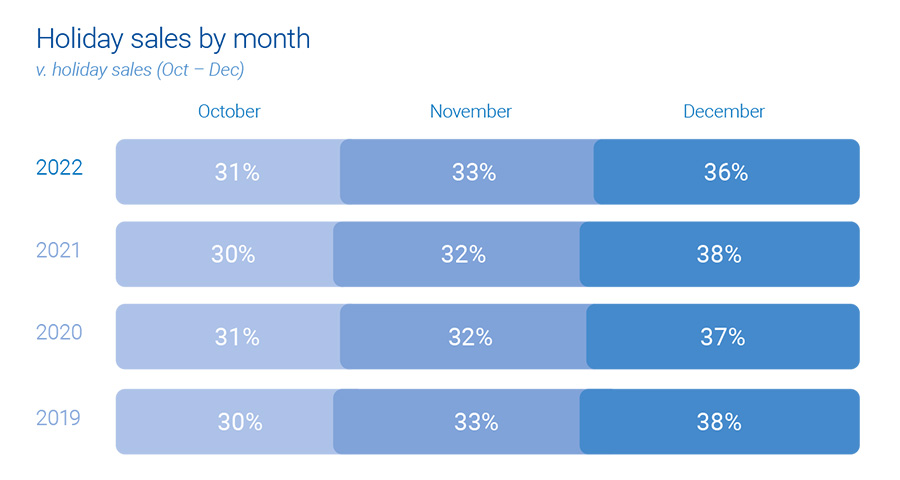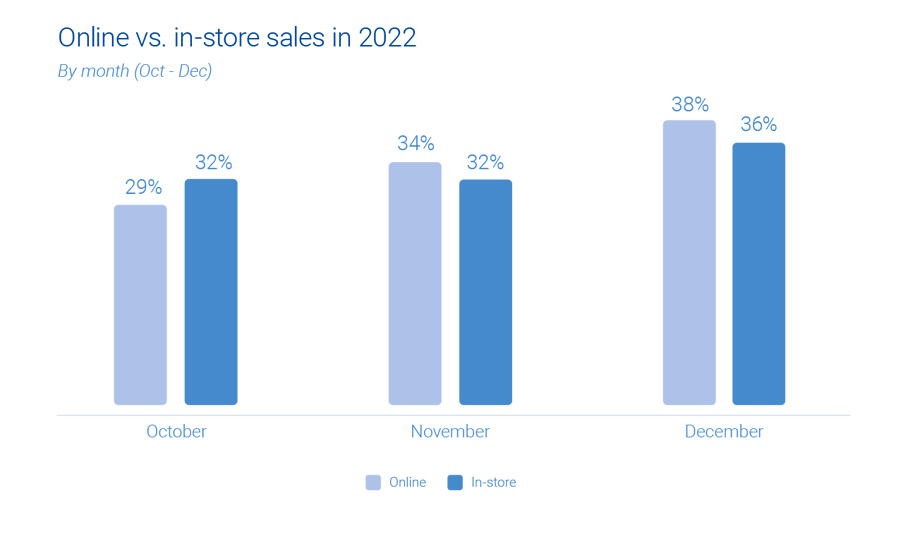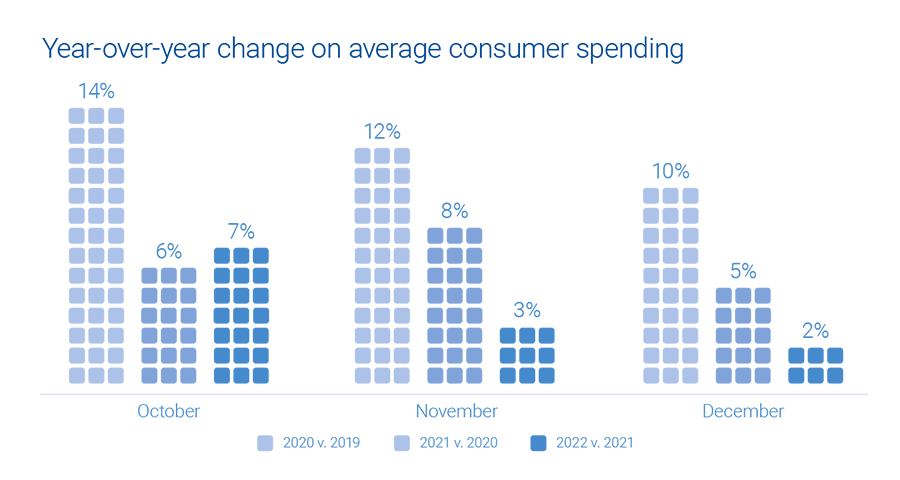
The holiday season is just around the corner, and retailers and marketers are gearing up for the busiest shopping period of the year. It’s crucial to understand how consumer behavior is evolving and what emerging trends to expect. Experian’s 2023 Holiday spending trends and insights report analyzes recent trends, consumer spending habits, and anticipates what’s to come in 2023 to help you deliver a top-notch shopping experience this holiday season.
In this blog post, we’ll cover three key insights from our report.
1. Consumers are shopping earlier
It’s no secret that December has always been the go-to month for consumers when it comes to holiday spending. However, holiday shopping now starts earlier, particularly with online sales.

This can be attributed to a surge in promotions and deals, enticing shoppers to open their wallets ahead of time, giving a significant boost to holiday sales. Notably, Cyber Week sales have proven to be an influential factor, accounting for 8% of total consumer holiday spending.
Experian tip
Reach the right shoppers with your promotions with sell-side targeting. This powerful approach gives you control over where your ads are placed while ensuring maximum visibility through direct connections with publishers. Whether on mobile, web, or CTV, this seamless ad experience will engage your audience effectively.
2. Online sales are on the rise
The popularity of online holiday sales is continuously growing, surpassing in-store shopping. There has been a consistent 1% year-over-year increase in online sales, while in-store sales have seen a 1% decrease.
“It’s easier for consumers to comparison shop for large ticket items online that they might find at a mass retailer or office supply store. Consumers prefer to have larger, bulkier items shipped directly to their home for minimal cost. By shopping online, consumers can save time since they don’t need to wait in checkout lines.”
Anna Liparoto, Sr. Account Executive, Retail & CPG

Although online sales currently make up only one-third of all holiday shopping, there is immense potential for further expansion. Mass retailers and office, electronics, and games industries particularly excel in online holiday sales. While in-store purchases remain the primary choice for holiday shoppers, consumer online and offline activities intersect before the final purchase.
Experian tip
Take advantage of the surge in online shopping by diversifying your marketing channels. An agnostic identity graph can bring together device and media data, capturing valuable user insights. By gaining a holistic view of your target audience, you’ll be able to optimize your ad spend and allocate resources effectively, ultimately boosting your return on investment.
“Omnichannel targeting during the upcoming holiday season will continue to prove to be the best way to reach scale and maximize ROI across all marketing channels.”
Joe LigÉ, Head of Enterprise Demand Partnerships
3. 2023 holiday spending will be on par with 2022
During the holiday season in 2022, consumer spending showed an anticipated increase, although the growth rate was slightly lower compared to previous years. October saw a surge in average consumer spending, indicating a swift response to early discounts and promotions offered by retailers.

As the holiday season progressed, holiday spending gradually slowed down and reached a level similar to that of the previous year. Overall, there was a modest 2% growth. Looking into the future, if economic conditions remain stable in the second half of 2023, we can expect holiday spending to align with the figures from last year.
Experian tip
To truly maximize impact, consider data enrichment. By diving deeper into your target audience’s preferences and behaviors, you can better tailor your strategies and seamlessly integrate the enriched data across various channels. This allows you to unlock the true potential of your ad inventory, creating more meaningful connections with your audience.
Download our 2024 report
Get ready for the holiday shopping season with Experian’s 2024 Holiday spending trends and insights report. Inside you’ll find:
- Analysis of past trends and what they mean for 2024
- Exclusive predictions for the upcoming holiday season
- The top audiences to activate this holiday season
To access to all of our predictions for this year’s holiday shopping season, download our 2024 Holiday spending trends and insights report today.
Latest posts

By now you’ve all seen the headlines about the burgeoning success of eCommerce compared to the relatively drastic decline in transactions for brick-and-mortar stores during the holiday season. ComScore data showed desktop online sales in the last two months of 2016 rose 12%, and are expected to rise to 16-19% once the mobile commerce numbers are tallied. This steady downward trend for brick-and-mortars has been caused by a variety of factors. Amazon has carved out a desire for free, fast shipping and one-stop shopping. The rise of “fast-fashion” pushes consumers to buy mass-produced and cheap clothing that is easiest to replicate online, and the wide-spread usability of eCommerce and mCommerce sites make the experience of online shopping hassle free. Many organizations have relied on the in-store experience to garner loyalty, so now the question is how to achieve that same experience in the digital realm as foot traffic to stores falls to all-time lows. The answer lies in understanding your users and tailoring content, not just products, within your communications. Experian Cross-Channel Marketing’s studies have shown that by incorporating editorial content into email, overall audience engagement can rise by up to 28% over audiences that don't receive content-driven messages. That’s an increase of over 20% in opens, clicks, and transaction rates! Now to be clear, this is content that is NOT focused on the sale, but rather, how the products, services, or organization can better the user’s life. Let’s dive into this a bit more deeply by talking about the types of content you can weave into your communication strategy: Product Tutorials This is the easiest to execute for those wanting to digress from the discount epidemic plaguing us all. Instead of flaunting a low price, highlight product versatility, create a video showing ease of use or wow the audience by demonstrating transformative effects with before and after photos. Bring the experience to them virtually rather than relying on a showroom to demonstrate the value. The more you draw your users into this experience, the more likely they are to remember your brand. Social Highlights + Celebrity Bloggers Many organizations spend a great amount of time and energy developing a solid social strategy, but fail to bridge the gap between social, email, the website, and even in-store experience. Pull favorite items, the highest rated products, or user-generated content into email to add a personal, more relevant touch to your brand. Also consider bringing any celebrity or blogger content to the forefront of your eNewsletters to achieve the same goal. After Your Purchase Experian has found that Welcome Emails containing a “Thank You” message for those that purchased produced 20x the revenue per email than promotional welcomes. These users are primed to purchase again as they have already shown interest in your organization, so why not incentivize another transaction immediately when appropriate? However, don't forget that the user journey doesn’t stop at the transaction. A huge part of customer satisfaction comes after the credit card has been swiped. Send communications to ensure the user knows how to care for their product, prepare for their service, or simply send a survey after their journey is complete. Including additional options to purchase should be secondary to making sure you get THIS transaction right. How It’s Made Is your product made in America, handcrafted, or come with special care that makes your brand stand out? Are your services or designers top rated for good reason? Give your customers a behind the scenes look to entice them and peak their interest in your brand. A Bigger Purpose Does your brand have a mission that will resonate in the hearts of your consumers? Is there a give-back program you think your audience will care about? If so, bring that bigger purpose to the spotlight and give your consumers a reason to be a part of your community. As your content strategy becomes more advanced, consider profiling your audience to understand their messaging preferences, and then test your content across these cohorts. Not all content will resonate with all customers, but finding the right content marketing mix will surely help your online presence stand out in a time where the digital experience is more important than ever.

Email marketing remains a marketer’s most powerful tool. It not only produces an impressively high ROI, it’s also highly measurable. It’s not uncommon to hear people boast about high deliverability as one of these metrics. However what does that statistic ‘deliverability’ actually mean? Statistics suggest that 1 in every 5 emails fail to land in the inbox [1] which means 20% of opportunities to connect with customers are being missed. Having great deliverability is what every marketer strives for but it is something that has been difficult for people to define. Now it’s not uncommon for words to have different meanings in different countries, the most obvious example being football. Deliverability, like football, has many different meanings No wonder Googling the term “deliverability” leaves you more confused than when you started. Metrics and people’s interpretation of their meaning is one of the biggest reasons for confusion around the topic of deliverability and many marketers mistakenly feel secure in their ability to reach subscribers if they have a high delivery rate. This however, isn’t necessarily the case… Delivered vs ‘accepted’ Often what marketers believe to be a measurement of their deliverability is in reality the proportion of emails that were ‘accepted.’ An email is considered to be delivered if it does not bounce or doesn’t get returned to the mail server stating it was unable to be delivered for a specific reason. Delivery rate is a calculation of mail sent minus the volume that bounced. Deliverability is making sure you are doing what you can to put yourself in the best position to be actually seen by your email subscribers. Not stuck in spam or ignored. Inbox placement is an ongoing battle for email marketers and is effected by many factors such as CAN-SPAM, PECR, CASL compliance, sender reputation, list hygiene, authentication and blacklisting. The number of active subscribers, open and click-through rates also can influence reputation with certain ISPs such as Hotmail or Gmail. Successful deliverability depends on a combination of best practices, including authentication and email reputation. The rules of deliverability go through perpetual change and proven techniques can prevent failures. Many people believe there is a silver bullet or a guarantee that a supplier can provide 99% deliverability rates, in reality sending mail to those who want it is the only truly proven way to get great deliverability. Deliverability is a critical element of email marketing and something that all marketers should be considering. Want to learn more about deliverability? Check out our ebook "You’ve got mail! Spotlight on email deliverability," where we offer a proactive strategy for building brand loyality and improving ROI through email deliverability and optimized email marketing programs. Read related posts about email marketing and deliverability here. [1] Return path Deliverability Benchmark Report http://returnpath.com/wp-content/uploads/2015/10/2015-Deliverability-Benchmark-Report.pdf Tom Corbett is an expert on Email Deliverability

Engagement matters. It matters to marketers and it matters to the consumer…but what is the most effective way to improve that engagement? We sat down with Marketing Expert, Liz McLemore to get her take on the top 5 marketing resolutions to improve your marketing programs. Resolution 1: Gain a full understanding of your data This year, strive to get a full picture of what data you have available. In order to really know who your customers are across all channels and be able to deliver meaningful experiences to them, you’ll need to consider what sources of data are available to you, and then who needs to have access to that data in order to best leverage it. Here are a few tips to get you started: -Collect demographic and behavioral data to get a clear picture of your customers. Combining these data types will help give you a better view of your audience. -Perform a comprehensive data audit to figure out exactly what your data is telling you. Document everything, from the data type to how often it’s updated. -Find a partner who can centralize your database and help you leverage unlimited data types and sources. Resolution 2: Amp up your personalization Your newly centralized data will allow you to better personalize the content and timing of your cross-channel communications. In order to make change executable, consider a phased approach to personalization. -Start small, with elements of your current template that can easily be personalized, such as headers or footers. -Enhance personalization through demographic or behavioral data, such as loyalty points. -Move toward a true 1:1 experience by partnering with a cross-channel communications provider who can help with state-based personalization. Resolution 3: Maintain a consistent approach When your customers interact with your brand, they should encounter a consistent brand experience. They don’t think in channels, so why should you? -View your brand as a customer would. Sign up for your emails, check out the in-store experience, and follow your brand on social media. -Compare your message across channels. Is the story you’re telling consistent? -Examine your internal operations, and work to remove silos. Cross-functional teams need to work together seamlessly in order to deliver a seamless cross-channel customer experience. Resolution 4: Adopt a mobile-first approach in every channel Customers do more than check email on their phones. Mobile commerce is growing, and a Business Insider BI Intelligence report predicts that mobile will account for 45% of all ecommerce by 2020. In order to take advantage of this growth, expand your mobile-first approach beyond the inbox. -Have a well-paved mobile path. Test the look and feel of your emails on a mobile device. Make sure that your website is mobile optimized, and that the path to purchase is as frictionless as possible. -When incorporating an SMS campaign, have a clear goal in mind. SMS campaigns can be effective ways to promote upcoming deals, cultivate loyalty, or inform, but it’s important to narrow your focus in order to best engage your customers. -Be compliant. If you do not have a mobile expert on your team, be sure to partner with one who can ensure your campaigns follow mobile compliance guidelines. Resolution 5: Measure effectiveness Now that you’ve put processes and plans into effect, measure their impact. -Work with your web, mobile, and social teams at the campaign creation stage to determine what metrics you need to measure, and why. In today’s cross-channel marketing world, it’s about more than open and click rates. -Compare your engagement rates to industry benchmarks to gain a better sense of how your brand is performing, but remember you need to be your OWN benchmark. -Invest in more sophisticated analytics programs to take your reporting to the next level, or seek the professional advice of experts who can show you how to separate the signal from the noise and gain deeper insights. These five tips and more are discussed in our webinar “Trends are Dead Ends: Create a clear road to success with our 2017 planning tips.” If you didn’t get a chance to join us, you can view a recording of it here. Also, if you want more information on our 2016 holiday insights please join us for our next webinar “It’s a wrap: 2016 holiday insights, “on February 23rd at 1pm ET.